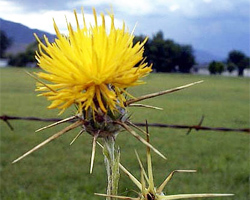Invasive plants
Invasive plants are plants that do not occur naturally in B.C. or are outside their natural range. The presence of invasive plants can cause environmental, cultural and economic harm, and some species can harm human health. They are extremely aggressive, reproduce rapidly, and often out-compete crops and native vegetation.
On this page:
- Pest management plans and pesticide use permits
- Early detection of invasive species and rapid response
- How invasive plants spread
- Invasive plants impact
- Invasive Plant Core Ranking Process
- Invasive aquatic and terrestrial plants
- Biological control
Pest management plans and pesticide use permits
Pest management plans and pesticide use permits provide direction and support for the use of integrated pest management activities to control invasive plants under the Integrated Pest Management Regulation.
Early detection of invasive species and rapid response
The B.C. government's approach to invasive species is to find, identify, and systematically eradicate, contain or control new invasive species before they can reproduce and disperse beyond their point of entry.
How invasive plants spread
Invasive plants are spread mainly by:
- Humans in the movement of whole plants, seeds, burs or root pieces
- Horticulture products
- Transported goods
- Machinery and vehicles
Soil erosion, over-grazing, off-roading and other forms of soil disturbance can further spread these invaders. In addition, spread occurs by wind, water, livestock and wildlife. Invasive plants can even be spread on footwear or clothing, and by pets.
Best Practices such as ensuring equipment and materials are free of invasive plant and limiting unnecessary disturbance can help limit the spread of invasive plants.
- Learn more about Best Practices For Preventing The Spread of Invasive Plants During Forest Management Activities (PDF, 6 MB)
- Prevent the spread of invasive plants during flood mitigation sediment removal by using the Invasive Plant and Knotweed Guidelines for Provincial Sediment Removal for Flood Mitigation (PDF, 250KB)
- If you plan to re-seed after disturbance, ensure your seed does not contain invasive plants by checking the Certificates of Seed Analysis (Invasive Plants Hiding in Seed (PDF, 462 KB))
Invasive plants impact
Invasive plants are capable of producing thousands of seeds per plant, which may lie dormant for many years. They pose a threat to the continued existence of many of our native species and the biodiversity of our environment.
Specific impacts of invasive plant infestations include:
- Disruption of natural ecosystem processes
- Alteration of soil chemistry—preventing the regrowth of native plants and economic crops
- Increased soil erosion
- Livestock and wildlife poisoning
- Increased risk of wildfires
- Interference with forest regeneration
- Allergic reactions, severe skin abrasions and burns on people
More than 320 terrestrial and aquatic plant species have been evaluated to determine likelihood of occurrence, establishment, spread and which pose the greatest threat to B.C.'s environment, economy and human health.
Invasive Plant Core Ranking Process
The invasive plant core ranking process is a tool that helps land managers make invasive plant management decisions. The tool helps invasive plant managers identify invasive plants that should be actively managed those that should be monitored.
Invasive aquatic and terrestrial plants
Integrated pest management is a decision-making process for managing pests and invasive plants in an effective, economical and environmentally sound way. Integrated pest management incorporates a variety of control and treatment options.
The B.C. government has evaluated more than 320 terrestrial and aquatic plant species to determine likelihood of occurrence, establishment and spread as well as to determine which pose the greatest threat. Currently 45 plant species are candidates for early detection and rapid response activities, and an additional 109 species are recommended for other levels of management.
Biological control
Invasive plant managers can use biocontrol agents to reduce invasive plant populations to ecologically and economically acceptable levels, and to prevent invasive plant encroachment into new areas. Biological control is part of an integrated pest management approach.
Report sightings

- Go to the IAPP database
- Go to the IAPP map display
Related links
Contact information
Contact us if you have questions about invasive plants.

